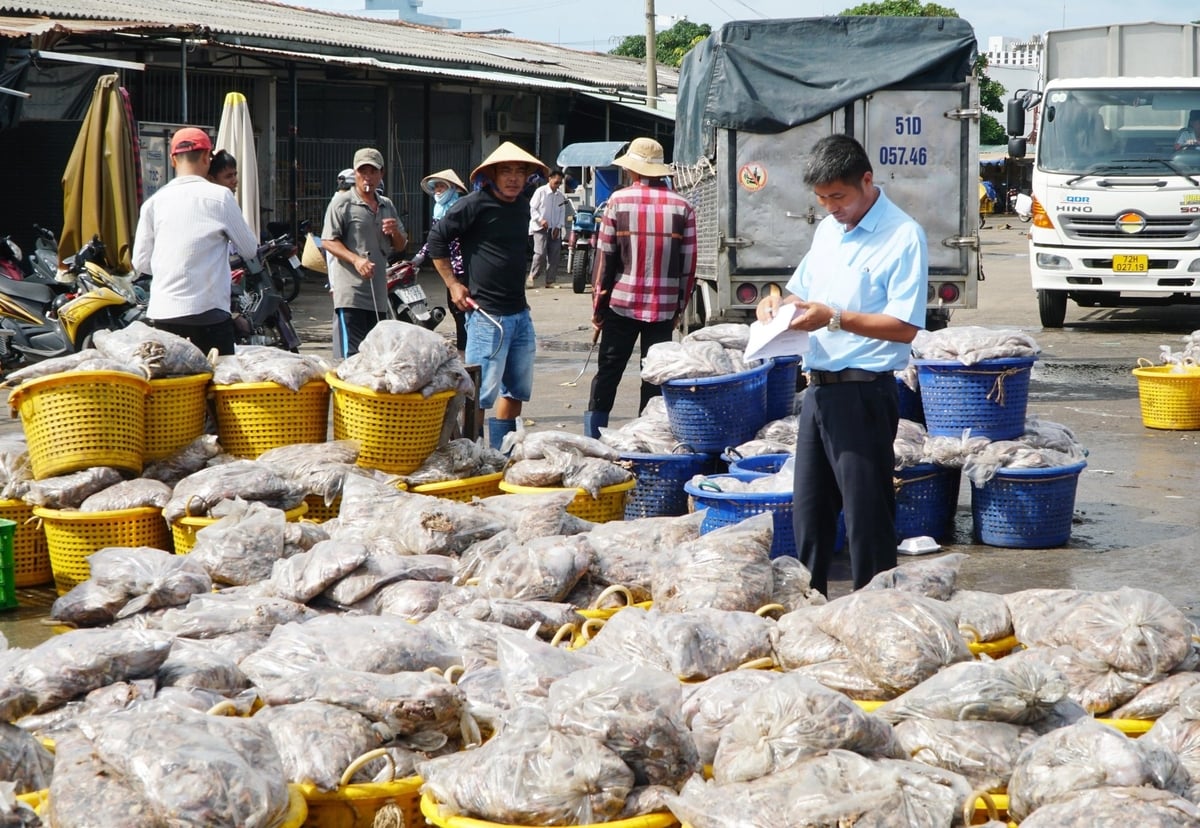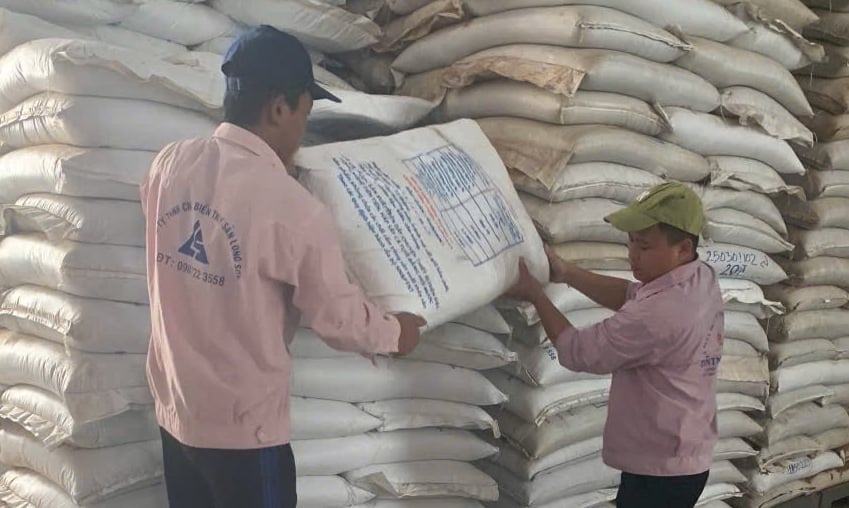October 30, 2025 | 16:56 GMT +7
October 30, 2025 | 16:56 GMT +7
Hotline: 0913.378.918
October 30, 2025 | 16:56 GMT +7
Hotline: 0913.378.918
According to the Ministry of Agriculture and Environment, Vietnam generates an estimated 160 million tons of agricultural waste and by-products per year. The seafood sector accounts for 0.6% of that: about 1 million tons, mostly shrimp shells, crab shells, fish skin, bones, viscera, fins, scales, and crustacean or bivalve mollusk shells.
Seafood by-products exist in solid, liquid, and gaseous forms, with solids accounting for over 90%. Except for bivalve shells, most of these by-products decompose rapidly under conditions of about 27 °C temperature and 80% humidity. If not handled properly, they can cause severe environmental pollution. However, if processed appropriately, these by-products can generate significant economic benefits.

Seafood has just arrived at Tan Phuoc Port (Long Hai Commune, Ho Chi Minh City), including various low-value mixed fish and by-products priced at only a few thousand VND per kilogram. Photo: Le Binh.
Seafood by-products contain valuable nutrients and minerals and are potential raw materials for many industries. Shrimp heads, bones, skin, fins, scales, and shells can be used to produce fish meal and shrimp meal for animal feed, organic fertilizer, and microbial fertilizer. They can even be processed into fish oil, collagen, and gelatin for the pharmaceutical and cosmetic industries. In addition, shrimp and crab shells can be used to extract chitin and chitosan: high-value materials in medicine and agriculture.
However, this potential remains underexploited. Currently, processing seafood by-products in Vietnam generates only about USD 275 million per year, while with proper investment, the figure could reach USD 4 to 5 billion.
The potential from by-products is even more evident for key products like brackish water shrimp and pangasius. In shrimp processing, by-products such as heads and shells account for 35 to 45% of total input weight and contain nutrients that can yield high-value products. Pangasius is mainly exported as fillets, which means by-products represent 60 to 70% of the total weight.
It is projected that shrimp export turnover in 2025 will reach USD 10 billion, corresponding to over 400,000 tons of by-products. By 2030, shrimp output is expected at 1.3 million tons and pangasius at 2 million tons. At that point, shrimp by-products would be estimated at 650,000 tons, with a value of VND 1,950 to 2,600 billion (USD 78 to 104 million) if sold at VND 3 to 4 million per ton. Pangasius by-products would reach 1.3 million tons, with a value of VND 10,400 to 13,000 billion (USD 416 to 520 million) if sold at VND 8 to 10 million per ton. These figures demonstrate the enormous economic potential when by-product processing is professionally developed.

By-products and leftovers from seafood processing and exports still hold significant untapped potential and economic value if properly recognized and systematically invested in. Photo: Le Binh.
The application of modern technologies, including enzyme technology, microbial technology, and molecular biotechnology, opens new avenues for the seafood industry under a circular economy model. Currently, around 30 to 40 Vietnamese enterprises have invested in processing fish meal, shrimp meal, collagen, and fish oil from seafood by-products. This is expected to increase the value of the production chain by 15 to 25%.
Phuc Loc Company Limited (Tan Hai Ward, Ho Chi Minh City), with over 25 years of experience producing fish meal for livestock and aquaculture, has fully utilized seafood by-products to manufacture fish meal. According to Mr. Nguyen Thanh Loc, the company’s Director, in the former Ba Ria–Vung Tau region, about 60 tons of by-products such as fish, crab, and oyster are discarded daily from fishing vessels and processing factories. Phuc Loc has invested in press machines to separate flesh from waste, then dries it into fish meal with 52 to 54% protein. Currently, the company produces 4,000 to 5,000 tons of fish meal annually, earning VND 72 to 90 billion with a sales price of about VND 18,000 per kilogram.
Despite their great potential, by-product processing in shrimp, pangasius, and seafood overall still faces many challenges. Outside the Mekong Delta, shrimp and pangasius production in many localities remains small-scale and fragmented, meaning no modern industry has formed. Logistics infrastructure for by-product collection, processing, and distribution is still weak, resulting in high costs, large losses, and rapid quality degradation.

Due to a lack of production technology, the processing of fishmeal from by-products and leftovers has not yet met expectations in terms of quality and output. Photo: LB.
Most processing facilities are small or medium-sized, with limited capital, outdated technology, and low-skilled labor, which restricts competitiveness and product transformation. The lack of a long-term development strategy also leads to widespread but ineffective investment.
Mr. Loc shared that because local authorities have not yet developed a comprehensive fisheries sector plan, the company has hesitated to invest heavily in technology and scientific advancement to scale up operations and improve product quality.
“I hope that after the merger, the new Ho Chi Minh City will adopt a detailed and complete development master plan for the seafood industry. With stable planning, Phuc Loc will invest in high-tech machinery to increase fish meal protein content to 60 or even 64%, which will raise the sales price by VND 10,000 to 15,000 per kg. Currently, the livestock feed sector still relies heavily on imported fish meal: about 140,000 tons per year,” Mr. Loc said.
Mrs. Pham Thi Na, Deputy Director of the Ho Chi Minh City Department of Agriculture and Environment, commented that utilizing seafood by-products not only brings economic value of tens of billions of dong per year but also contributes to environmental protection and promotes a circular economy toward green, sustainable agriculture.
* USD 1 = VND 26,145. Source: Vietcombank.
Translated by Huong Giang

(VAN) After years of intensive cultivation, agricultural soils are becoming exhausted. Efforts to restore soil health and regenerate soil ecosystems are now being initiated.

(VAN) Expanding the smart coffee cultivation model not only contributes to increasing farmers’ income but also enhances climate change adaptation in the Central Highlands.

(VAN) A comprehensive MRV process for high-quality rice cultivation has been finalized and is now ready to accurately measure and assess emission reductions.

(VAN) Hundreds of thousands of hectares of aging, low-yield coffee in the Central Highlands have been 'rejuvenated' through the replanting program, delivering significantly higher productivity than before.
/2025/10/29/2359-1-171705_4.jpg)
(VAN) Wood plastic composite made from recycled plastic combined with wood and stone powder is being piloted, with the expectation of collecting and recycling a large volume of plastic waste each year.

(VAN) The FAO-funded project aims to control banana wilt disease nationwide, with five key outcomes targeted toward sustainable banana production.

(VAN) The Integrated Plant Health Management (IPHM) helps farmers in Quang Ngai increase rice production efficiently and sustainably.